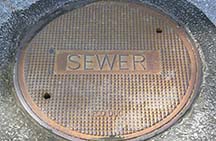Greensboro’s wastewater-treatment system neatly handled the torrents of water dumped on it by Hurricane Florence – but just barely.
During the heavy rainfall from Florence, Greensboro’s two wastewater-treatment plants processed 140 million gallons per day (mgd) – a hair under their 142 mgd capacity, according to Adam Conn, operations manager for the city’s Divisions of Water Resources.
Florence tested the city’s wastewater systems to their limits, causing three discharges of untreated sewage totaling about 2 million gallons. By far the largest of the three occurred Monday, Sept. 17, when 1.3 million gallons discharged from the Reedy Fork Lift Station on McLeansville Road, one of the city’s most technologically advanced stations, but which is heavily dependent on electronics that cut off when submerged.
“The number is high mostly due to the inaccessibility of the stations due to floodwater,” Conn said. “We literally couldn’t get to the 1.3 million gallon spill because the station was submerged in two feet of floodwater.”
The Reedy Fork station discharged sewage for about 23 hours until flooding from Middle Reedy Fork Creek subsided enough for workers to install an emergency pump to an 8-inch bypass connection built into the station. The Reedy Fork station is still out of commission and is expected remain so for three to four weeks. The station normally pumps 1.3 mgd to 1.5 mgd.
The second-largest spill, also on Monday, was 625,000 gallons of sewage from a manhole at 3844 Battleground Ave. near Horse Pen Creek. High-pressure sewage blew the cover off the manhole. Workers couldn’t replace the manhole cover until the pressure subsided 17 hours later.
The system lost 63,000 gallons of sewage from an 8-inch sanitary main at 1600 West End Place on Sunday.
The Reedy Fork discharge drained into Middle Reedy Fork Creek. The manhole discharge on Battleground Road drained into Horse Pen Creek. Greensboro is in the Cape Fear River basin, which means all the spills make their way to the Cape River, which is currently in flood.
Conn said the city tested downstream water and found no contamination. He said workers cleaned up rags and other solid items and applied lime where water was found to be acidic, which most sewage is.
“In the scale of things those discharges are huge compared to a normal non-storm-event type of discharge,” Conn said. “The volume is large, but there is also so much water flowing through the system that you get a dilution factor.
The Divisions of Water Resources estimates it will cost $100,000 to $150,000 to repair the Reedy Fork station and up to $35,000 to repair the Horse Pen Creek station.
“I feel bad for these folks who got even more than us nearer the cost,” Conn said. “We did a lot of prep for our stations, but when it’s over a large area it’s hard to manage it.”

